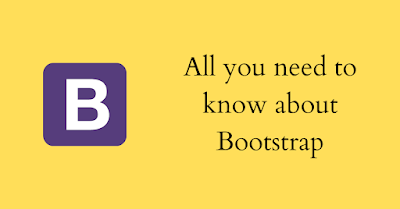You can learn about Bootstrap's basic structure, CSS, Layout Components, and Plugins in separate sections of this lesson. Here, you'll find information on a wide range of subjects that can be applied in real-world contexts.
Why Learn Bootstrap?
- Bootstrap 3's framework includes mobile-first styles throughout the entire library, rather than just in the framework's mobile-first files.
- Almost all popular browsers have support for it.
- Bootstrap is easy to use if you have a basic understanding of HTML and CSS. Detailed instructions and examples may be found on the official Bootstrap website.
- A responsive design enables Bootstrap to adapt to various devices, including desktops, tablets, and mobile phones. In the chapter Bootstrap Responsive Design, you'll learn more about responsive design.
- Clean and uniform solution for the development of an interface.
- In addition, it has a wide range of built-in features that are easy to configure.
- Web-based customization is also available.
- It's free and open-source, which is a bonus.
Bootstrap Tutorial for Beginners:
Precompiled and source code versions are available for Bootstrap. You can use either less CSS preprocessor, but there is an official Sass adaptation of the Bootstrap framework if you prefer Sass. So, Bootstrap Tutorial For Beginners makes use of Auto prefixer to make CSS vendor prefixes more accessible.
The source code version includes the Less (or Sass) style sheets, all of the JavaScript, and the accompanying documentation. As a result, the more ambitious designers and developers can alter and tweak Bootstrap to their specifications. Don't worry if you don't know how to use the Less (or Sass) language or don't want to mess with the source code. You can use the vanilla CSS that has been precompiled. Custom styles can be used to override any of the default styles.
Applications of Bootstrap
- Scaffolding: Bootstrap gives a basic structure using the Grid System, link styles, and background color. The section on Bootstrap's fundamental structure goes into great length about this.
- CSS: All essential HTML components may be decorated and expanded with extendable classes thanks to Bootstrap's global CSS settings. To learn more, see the section on Bootstrap and CSS.
- Components: Over a dozen reusable components are included in Bootstrap, including icons, dropdowns, navigation, alarms, pop-overs, and more. Layout Components explains this in great detail.
- JavaScript Plugins: Over a dozen bespoke jQuery plugins are included in the Bootstrap framework. You can include them all by one or all at once. In the section Bootstrap Plugins, you'll find more information about this.
- Customize: It can personalize the Bootstrap framework by changing the components, fewer variables, and jQuery plugins.
Bootstrap Interview Questions
Here are some Bootstrap Interview Questions:
1. Why should you use Bootstrap?
Answer: Bootstrap has the following advantages:
- Bootstrap is easy to learn and can be used by anyone with a working knowledge of HTML and CSS.
- Features that adapt to smartphones, tablets, and computers: Bootstrap's responsive CSS adapts to these devices.
- A mobile-first strategy: The Bootstrap framework is created with mobile-first styles in mind.
- When it comes to current browsers, Bootstrap 4 is compatible with all.
2. What is a Bootstrap Container, and how does it work?
Answer: Our site content can be placed in the main page area thanks to a bootstrap container class. Our other HTML code is contained within Bootstrap. Responsive container. A container is a form of padding for the stuff inside of it, and there are two types:
- A responsive, fixed-width container is created using the. Container class.
- Full-width containers are created with the container-fluid class, which uses the complete viewport width.
3. How can you use Bootstrap to make thumbnails?
Answer: Follow these steps to create Bootstrap thumbnails: Thumbnail images should be included in a tag with the class="thumbnail." It will add four pixels of padding and a grey border. When the image hovers over, an animated light will outline it.





0 Comments